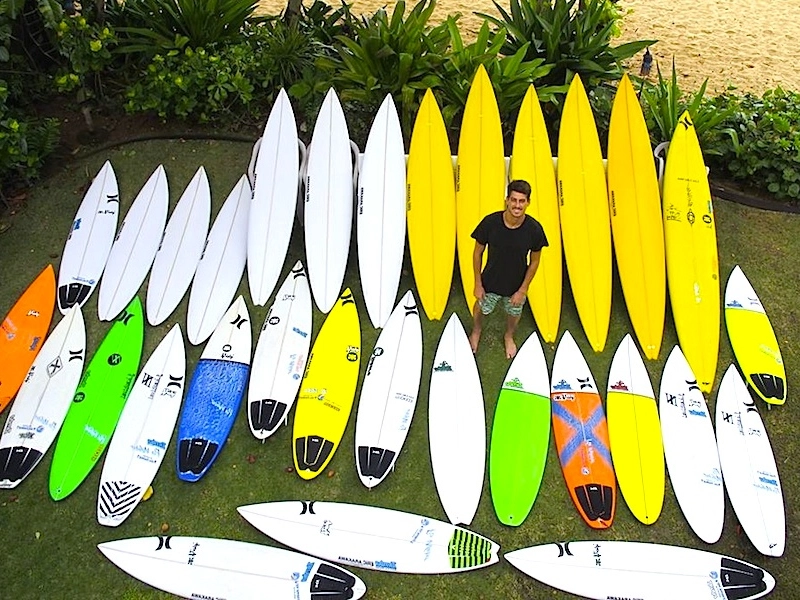Selecting the appropriate surfboard is essential for enjoying your time in the water and enhancing your surfing skills. The wrong board can negatively impact your experience, even for seasoned surfers. The ideal board for you will depend on your skill level, the conditions you'll be surfing in, and your personal preferences. Read on to discover more about the process of choosing a surfboard:

 In addition to length, the shape of a surfboard is one of the most significant decisions for beginners. A wider nose will prevent the board from sinking during the catch, but it may limit performance once riding the wave, while a narrower tail can provide better control in the water.
The type of rocker, or curve, on the nose and tail also impacts performance. A more pronounced curve can help prevent nose-diving and perling (sliding down the face of the wave, either left or right). However, excessive rocker can make it difficult to maneuver in smaller waves.
Other modifications include the fishtail—a swallowtail with an exaggerated "V" in the center that reduces drag and increases speed on small waves. Elliptical channels on the bottom of the board enhance speed by flushing out water and are commonly found on longboards, hybrids, and thruster models.
In addition to length, the shape of a surfboard is one of the most significant decisions for beginners. A wider nose will prevent the board from sinking during the catch, but it may limit performance once riding the wave, while a narrower tail can provide better control in the water.
The type of rocker, or curve, on the nose and tail also impacts performance. A more pronounced curve can help prevent nose-diving and perling (sliding down the face of the wave, either left or right). However, excessive rocker can make it difficult to maneuver in smaller waves.
Other modifications include the fishtail—a swallowtail with an exaggerated "V" in the center that reduces drag and increases speed on small waves. Elliptical channels on the bottom of the board enhance speed by flushing out water and are commonly found on longboards, hybrids, and thruster models.
 The fins you choose will significantly affect your surfboard's performance. It can take years of surfing to fully understand which fins work best with which board and in what conditions.
You can get molded fins that come with most surfboards sold in stores or opt for custom-made fins from a surfboard shop. Most surfboards also feature FCS or Futures fin boxes that accommodate various fin types.
The material of a fin influences its flexibility and performance. Stiff materials like carbon or fiberglass provide consistent drag force and enhance speed, while softer materials like EPS or honeycomb construction flex with the board's movement, improving maneuverability. The fin's shape also plays a crucial role; the design of the outer and inner faces alters water flow, creating laminar or turbulent flow. Laminar flow maximizes lift and minimizes resistance to sideways motion.
The fins you choose will significantly affect your surfboard's performance. It can take years of surfing to fully understand which fins work best with which board and in what conditions.
You can get molded fins that come with most surfboards sold in stores or opt for custom-made fins from a surfboard shop. Most surfboards also feature FCS or Futures fin boxes that accommodate various fin types.
The material of a fin influences its flexibility and performance. Stiff materials like carbon or fiberglass provide consistent drag force and enhance speed, while softer materials like EPS or honeycomb construction flex with the board's movement, improving maneuverability. The fin's shape also plays a crucial role; the design of the outer and inner faces alters water flow, creating laminar or turbulent flow. Laminar flow maximizes lift and minimizes resistance to sideways motion.
 Surfboards can be customized with various add-ons, including surfboard wax, leashes, and fins, all of which can optimize the board's performance for specific conditions.
For example, if gravity were the only factor in generating speed, you might assume your board would go fastest when dropping down a wave face, but that's not the case. Your board actually generates the most speed when it is in trim across the face of the wave.
Fins are an important add-on for your surfboard, determining how well it can maneuver and turn. Consider your surfing style, skill level, and prevailing wave conditions when selecting the appropriate fin type. You can choose between single fins, thruster (3-fin) setups, or quad (4-fin) setups. Some surfboards also feature concave bottom contours that redirect water flow while adding lift, known as biolos, which perform particularly well in clean, powerful surf.
Surfboards can be customized with various add-ons, including surfboard wax, leashes, and fins, all of which can optimize the board's performance for specific conditions.
For example, if gravity were the only factor in generating speed, you might assume your board would go fastest when dropping down a wave face, but that's not the case. Your board actually generates the most speed when it is in trim across the face of the wave.
Fins are an important add-on for your surfboard, determining how well it can maneuver and turn. Consider your surfing style, skill level, and prevailing wave conditions when selecting the appropriate fin type. You can choose between single fins, thruster (3-fin) setups, or quad (4-fin) setups. Some surfboards also feature concave bottom contours that redirect water flow while adding lift, known as biolos, which perform particularly well in clean, powerful surf.